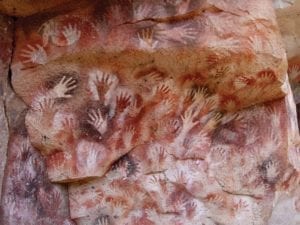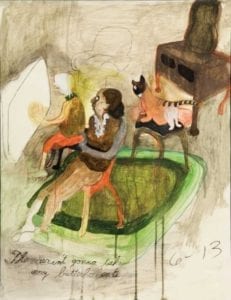I Was Here: A Look At Why We Create

Part of the Cave of the Hands in Santa Cruz, Argentina. ca. 9,300 BP
This article was published in the May 2015 issue of Nashville Arts Magazine
by Rachael McCampbell
It’s amazing to think that visual and sculptural arts were around almost 30,000 years before the first language was recorded. Humans have always possessed an inherent need to express ourselves through art. Before the majority of the world could read, or the invention of the printing press, visual art was often the platform used to illustrate stories and communicate ideas to the masses (think of medieval narrative paintings of Biblical stories by Cimabue and Giotto and, later, cartoons). Art commissioned by the Catholic Church lead to private commissions by wealthy patrons of portraits, neoclassical themes, and scenes of ordinary life. Romanticism of the late-eighteenth and the nineteenth centuries opened the doors for artists to express what they wanted to paint—their personal thoughts, observations, and feelings. This was a pivotal change that lead to all the “isms” and art movements we have today: Impressionism, Symbolism, Expressionism, Cubism, Futurism, Surrealism, Constructivism, Minimalism, Neo-expressionism, along with Installation, Performance, and Conceptual Art, to name a few.
So why do we make art today? Here are some reasons:
To add beauty to a space
To tell a story
To make a political statement
To express personal thoughts or feelings
To initiate and document societal changes
To honor a religion
To decorate or adorn objects
To make a living
To spotlight environmental issues
Of course when I say “art,” I don’t mean just visual arts. This term covers all forms of expression from music, dance, literature, poetry, storytelling, to filmmaking and more.

Aggie Zed, They Aren’t Gonna Take Any Butterball Cats, Pastel, ink, and acrylic on paper, 40” x 26”
Sometimes I wonder what our lives would be without art. Imagine not having music or stories in your life or visuals of any kind. I believe that the arts help us engage in our whole selves so that we may experience our fullest range of human expression. Partaking of the arts also helps us better understand ourselves as individuals within a society and connects us to our culture and to cultures throughout the world.
I asked some artists why they make art. Nashville artist John Jackson said, “I’m compelled to make art and paint because it gives purpose to my life. I paint because it motivates and pushes me to reach my potential—to think, expand, and progress. Without painting I’m just a stagnant animal.”
The whimsical artist Aggie Zed said, “Mostly I build the things I build and paint the things I paint because I am curious. I want to see what the characters in my drawings and paintings will do next. I never know when I start a drawing who will show up and what animals they will have. I always hope they will make me bust out laughing.”
Leslie Satcher, a highly successful Nashville songwriter and painter, says she writes and paints because “I can’t help myself—it just pours out of me. Even when I was working a 9-to-5 job, I had to find ways to express myself. Now I make my living 100 percent through art. It’s my haven. I find peace through making art.”

Part of the Cave of the Hands in Santa Cruz, Argentina. ca. 9,300 BP
As I look at the cave paintings “Cueva de las manos” in Argentina and see all the stenciled hands left for eternity there, I wonder what their motivation was to make art. As we face our inevitable mortality, perhaps the ultimate reason we make art is simply to say, “I Was Here.”
